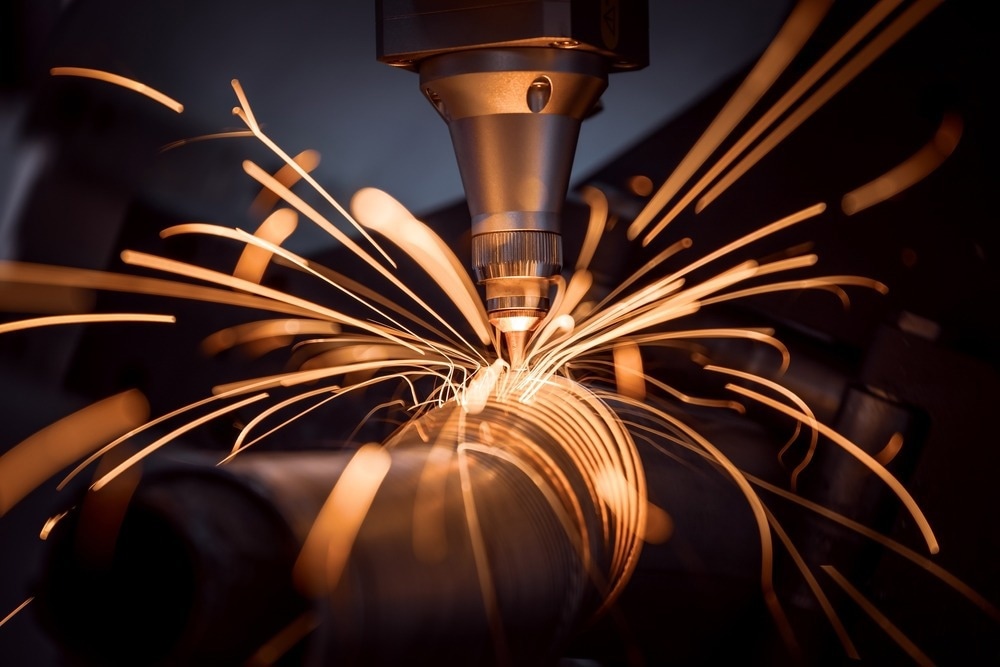A recent study published in Instruments develops and characterizes a low-cost carbon dioxide (CO2) laser system that emits monochromatic coherent laser radiation in the infrared spectrum. The researchers used ZEMAX optic studio to design and develop the laser cavity. A switch-mode high-tension pump source was devised using a fly-back transformer to examine the voltage behavior at various node locations. A prototype cooling system using thermo-electric coolers was constructed to eliminate the surplus heat generated by laser activity.

Study: Design, Construction, and Characterization of Sealed Tube Medium Power CO2 Laser System. Image Credit: Andrey Armyagov/Shutterstock.com
Potential Advantages of the CO2 Laser
The CO2 laser is one of the most attractive, effective, and useful lasers. The CO2 laser produces substantial heat, which is used as a primary property in various applications and operates in the infrared band.
In recent years, super-pulsed carbon dioxide lasers have been used extensively in various medical and aesthetic procedures. Industrial processes also use CO2 lasers.
Improved efficiency and operational reliability are crucial for industrial applications, the most common being material cutting.
The advantages of CO2 laser cutting include admirable accuracy, a small incision width, and a clean surface.
The development of CO2 laser technology enables applications in several sectors, including medicine, industry, and agriculture. CO2 lasers improve daily lives and elevate the industry to a new level.
Traditional Designs of CO2 Lasers
CO2 laser systems with two gas absorption cells put into the cavity have been created and tested. The proper selection of absorbing gases enables high-power pulsed operation over a range of wavelengths from 9.08 µm to 10.6 µm at repetition rates up to 100 kHz. This laser operates in a single axial mode with a frequency stabilization of more than 100 kHz at the height of the power profile. Peak power ranges between 0.1 and 5 Watts.
Researchers have also created the Zodiac geometry, a high-power 24-channel radial array slab RF-stimulated carbon dioxide laser. This laser has a maximum output power of 15 kW.
The laser uses four operating modes (single shot, continuous wave, periodic pulse, and processing velocity-dependent power). The peak power of a single CO2 laser beam could reach a record 15 TW.
Limitation of Current CO2 Lasers
Although CO2 laser efficiency has improved over time, commercially available lasers are still relatively expensive. Many small businesses and academic institutions cannot afford commercially available CO2 lasers.
Development of a Low-Cost CO2 Laser
Naeem et al. demonstrated the design, construction, and characterization of a low-cost, medium-power CO2 laser system. The researchers used a switch-mode power supply and a prototype cost-effective homemade chiller for the suggested CO2 laser system. Thermoelectric coolers and small aluminum blocks were used to construct a low-cost prototype chiller.
The researchers also covered the characteristics, construction, and uses of the low-cost CO2 laser. Their method for creating the CO2 laser was simple. They created a cost-effective and effective medium-power CO2 laser system using a sealed tube high-tension pump source and an unconventional cooling system with thermoelectric coolers.
Research Findings
This research used a prototype chiller with thermoelectric coolers and fly-back-based high voltage power supply to develop a low-cost sealed tube medium power (40 W) CO2 laser system.
A high-tension pump source was created to produce the necessary high voltage in the range of kilovolts (8 kV to 30 kV) in the cavity using the fly-back transformer and driver circuit.
A thermoelectric cooler was used to design and construct a prototype cooling system to keep the laser cavity temperature constant. The cooling system reduced the water's temperature by 8 °C at a rate of 0.7 °C per minute, which was sufficient to offset the heat produced by the tube and keep it stable for an extended duration of the operation.
Studying the effectiveness and performance of the cooling system at various laser output powers revealed that the chiller was stable and kept the cavity temperature constant during the long-term operation of the laser.
When power, current, and applied voltage were compared, it became clear that increased applied voltage resulted in enhanced laser power as more current flowed through the tube.
Investigation of the laser beam's penetration rate into pink salt rock, wood, and acrylic sheet (PMMA) at various output powers revealed that the rate of penetration through the material improved as the output power increased.
Pink salt rock had a lower laser penetration rate than an acrylic sheet (PMMA) due to its high melting point.
Reference
Naeem, M., Imran, T., Hussain, M., & Bhatti, A. S. (2022) Design, Construction, and Characterization of Sealed Tube Medium Power CO2 Laser System. Instruments, 6(4), Article 4. https://www.mdpi.com/2410-390X/6/4/72/htm
Disclaimer: The views expressed here are those of the author expressed in their private capacity and do not necessarily represent the views of AZoM.com Limited T/A AZoNetwork the owner and operator of this website. This disclaimer forms part of the Terms and conditions of use of this website.